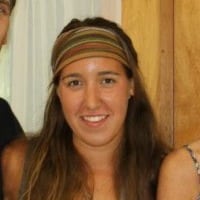Some were shocked, and some knew it was coming. When readers of the magazine, Marathon & Beyond, opened to the first page of the publication’s final edition, they read the editorial no one wants to read and no editor ever wants to write.
You hold in your hand the 114th issue of Marathon & Beyond. It is also the last issue of Marathon & Beyond.
Due to a steady decline in subscriptions over the past several years, the magazine is no longer able to sustain itself in a media environment that is rapidly—and inexorably—changing. –Rich Benyo, editor of Marathon & Beyond magazine
The announcement was made this past October. The esteemed magazine was being discontinued after almost 20 years of publication. Sure, it wasn’t of The New Yorker status, but to runners and ultrarunners it was the bi-monthly bible for the running community.
Rich Benyo and Jan Seeley were the backbone duo of the magazine. They took over the magazine, distributing it from their new headquarters in Champaign-Urbana, Illinois.
Jan always had ambitions to go into journalism and publishing, but a stint playing on the U.S. National Field Hockey team and teaching led her down several different paths before finding M&B.
Jan, 56, was born in Weymouth, Massachusetts, and after one year of cross country for her high school, Jan jumped into field hockey, making her way onto both her Yale University varsity team and the U.S national team. She was the first alternate to the 1980 Olympic Field Hockey squad.
Her teammates missed out on the Olympics when the U.S. boycotted in 1980. Two years later at her graduation from Yale, she had a decision to make: start her adult life or try to make the 1984 Olympic team.

Jan with her friend Ashley Eisenmenger after the Champaign, Illinois Women’s Fitness 5k Run, which Jan directs. She is one of the guides who helps the visually-impaired Eisenmenger train.
“1980 was the first year field hockey was an Olympic sport,” she said. “I was a baby! I was only 20, and all these other women were in their late twenties and thirties.”
She decided to not go for the 1984 Olympics and instead began teaching and coaching at a Connecticut prep school. After five years, she and her now late husband, Joe, a Yale classmate, moved to Illinois in 1987 to attend the University of Illinois for grad school, Jan in English, and Joe in computer science.
“I figured I would go right back into the classroom after grad school, and I just wanted to be a better English teacher,” she said.
Instead, she heard about an opening at Human Kinetics.
“It was the swing back to where and what I wanted to do while in high school,” she said, as she first stepped back into the journalism field.
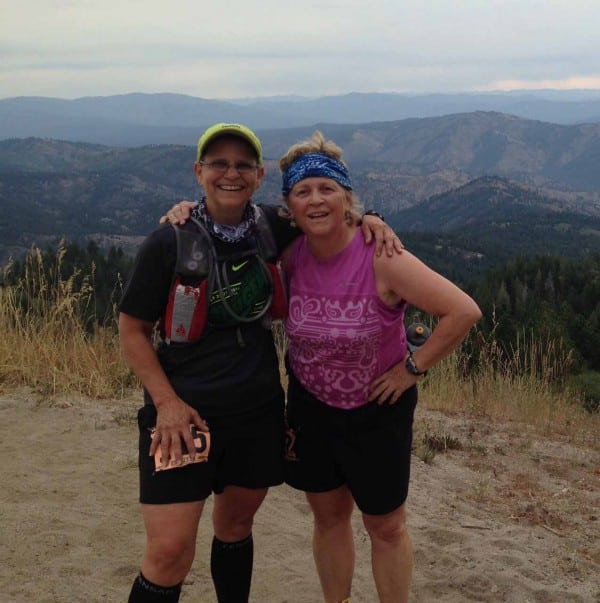
Jan with her friend, Jenny Stinson, during the 21-mile Bogus Basin Trail Run in August of 2015.
It was in that world, where she met Rich and the magazine, M&B, was born.
Rich, now 70, was born in Pennsylvania on the same day as Adolf Hitler, Mohammed, Napoleon, Harold Lloyd, and Johnny Tillotson, a fact he proudly likes to share. In 1968 he graduated from Bloomsberg University, where he majored in English literature, with a “smattering” of journalism, and ran cross country.
He started running as a kid as a way to beat the bullies, he told me.
“I had a stuttering problem from five years old when I woke up while having my tonsils taken out,” he said. “The older kids used to beat up on me, so I learned that if I got a few steps head start on them, I could outrun them.”
His running really took off while working at Runner’s World Magazine in 1977, but before that, from 1972 to 1977, he was the editor of Stock Car Racing Magazine in Alexandria, Virginia. At that time, Rich was following the NASCAR circuit and gaining a few unwanted pounds, he admitted.

Rich Running cross country in 1966 at Bloomsburg University in Pennsylvania.
In August of 1977, he moved to California for the Runner’s World position, added miles, and dropped the pounds. The next year he ran eight marathons and entered the Cow Mountain 50 Mile, put on by Gordy Ainsleigh.
“Gordy drove to various spots on the course in his huge Cadillac setting up ‘aid stations,’ which consisted of him dropping off Body Punch (a version of Gatorade) into horse troughs,” he recalled. “We had to push the horse whiskers out of the way to dunk our water bottles in to get fluid.”
The water bottles were the plastic bears that honey comes in, he said.
In those days, ‘races’ were more like fun runs without race entry fees and prizes.
“I think what hooked everyone was the camaraderie,” he said. “In those days we were outlaws, an aberration, weirdos, so there was a viral and spiritual connection between runners.”
His connection to the running community grew while working at publications throughout the country and devoting any extra time book writing.
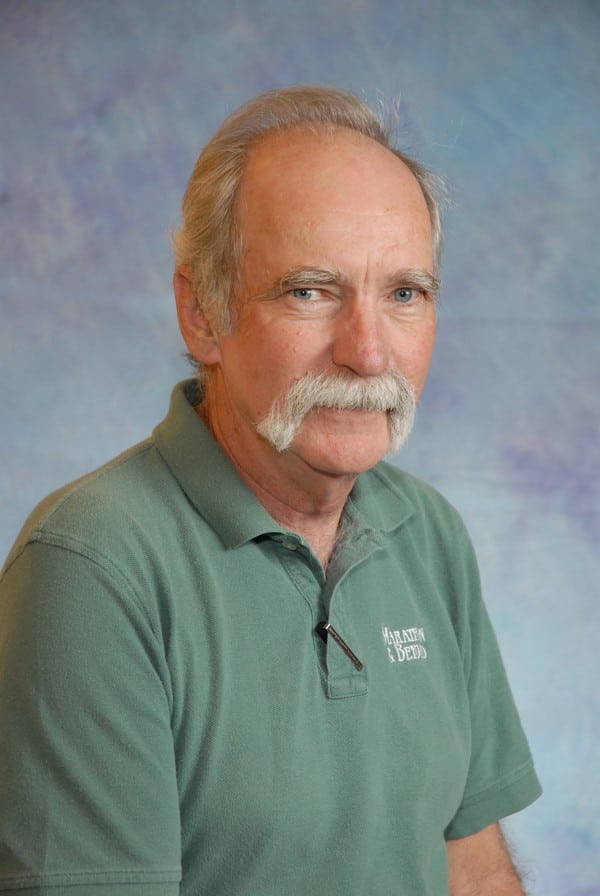
Rich posing for a Running USA Conference portrait in 2006.
Out of college, he began managing a local Pennsylvania newspaper, The Times News, and started co-directing a 10k race called the Switchback Scamper. Within a year he started freelancing, which led him to the Stock Car Racing position, and there, he met Hal Higdon who was writing articles about racing. Higdon later pitched Rich’s name to become the next Runner’s World vice president of publications, which led him to California in 1977.
Still with me? Well, there’s more.
1977 was the year of his first published book, Superspeedway, which chronicled the 1976 the NASCAR grand national season. He went on to write several running books while working at Runner’s World, Return to Running and Master of the Marathon, and he co-authored several books with his wife, Rhonda, including Indoor Exercise Book.
In 1984 he left Runner’s World to write the “Running and Fitness” column for the San Francisco Chronicle, co-wrote five more books with Elaine LaLanne and did two long pieces for The New Yorker.
In 1997, Human Kinetics published Rich’s books The Exercise Fix and The Running Encyclopedia. Later, in 2008, the University of Scranton Press published Jim Thorpe Never Slept Here (Rich’s childhood memoir). In 2009 they published his book of short stories, called Leap of Faith, and The South Street Gang Vs. the Coalcracker Cyclops in 2010, which is a kids’ book. Since then, Rich has published Mauch Chunk (an alternate world detective novel), Jim Thorpe Made Us All Olympians (Rich’s high-school memoir), The South Street Gang Goes Downhill-Fast!, and Roughing It, Too (a time-travel novel).
Coming in 2016, he’ll have The South Street Gang Vs. Felix the One-Arm Ghost and Pyramid.
“The whole concept of M&B was a phoenix of The Marathoner, a quarterly I launched at Runner’s World in 1978 to cover the burgeoning world of marathons and ultras,” he said. In the early years of the magazine, Joe Henderson, the Runner’s World editor, kept track of all race performances on 3X5 cards.
“As marathoning exploded, we had so much material for the January issue we had to break it into two parts and carry it in the January and February issues. It was too much, so I proposed a perfect-bound quarterly publication that would concentrate only on marathoning and ultras, hence The Marathoner.
The publication unfortunately only lasted five issues.
“I always lamented the loss of The Marathoner, because I thought it was the right magazine at the right time,” he said. “So, the proposal I put together was a revival of the concept of The Marathoner.
The proposal was submitted in 1996 and M&B started in 1997. M&B took on the 6X9 book format, published six times a year and in full color for the last six years. It grew from 128 pages to close to 200, and at its discontinuance of publication has published 114 issues.
“The articles were as good now as they were back then,” Jan said. “The content was timeless. Unique.”
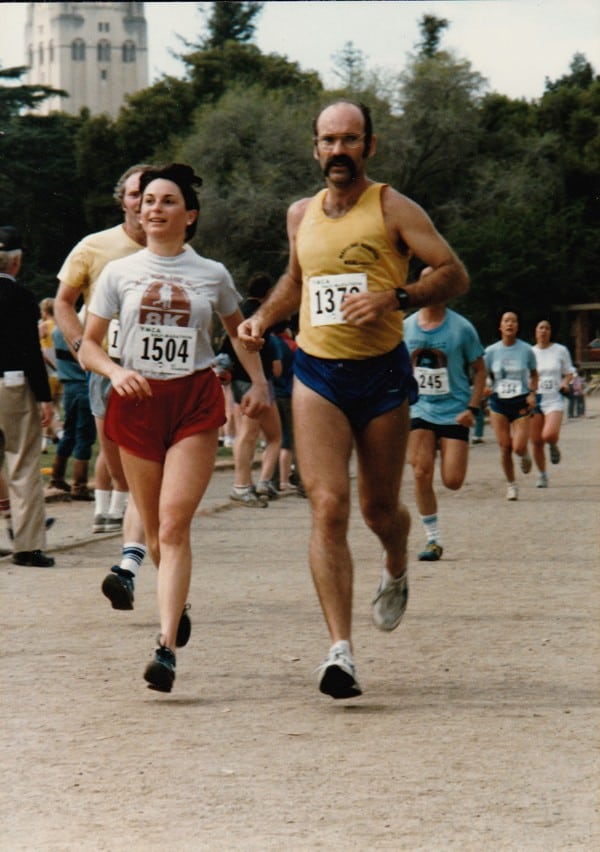
Rich running with his wife, Rhonda Provost, during a 10k race in Stanford in the early 1980’s. They hopped into the race during a long run.
Human Kinetics published the journal until 1998, and then announced they had to fold it.
“Jan interceded, and we came up with a plan to take the magazine off their hands, paying them quite a few years, and we were suddenly owners,” Rich said.
Jan became the publisher and co-owner with Rich, who remained as editor. While he worked as the editorial editor, managing the articles, writers, and photographers, Jan was all production. She worked with the layout, budgeting, finances, and advertising.
“We both wore a lot of different hats,” she said.
Among those hats were the directors caps for races as well. Both Jan and Rich co-direct races in their hometowns.
Jan is the co-director of the annual Christie Clinic Illinois Marathon, which starts at the campus of the University of Illinois in Champaign and finishes at the 50-yard line of the school’s football stadium.
The race is held the last weekend of April, and Jan works around the clock managing a 70-person committee, 65 sponsors, and 20,000 racers.
She is responsible for the overall execution of the race.
“I love creating the experience for participants,” she said. “As soon as they step foot into our community they feel welcome and have a great time.”

Jan in race-director mode at the 2014 Christie Clinic Illinois Marathon.
Jan makes it a priority to as answer every phone call and every question a runner may have. She listens to each person’s feedback.
“The hospitality of our community is at the top,” she said of her marathon. “The entire community supports the runners. They feel that love and that is not typically seen at large marathons.”
The Chicago Marathon has screaming fans around every corner, and The Boston Marathon is historically well-known, but this Champaign marathon treats every runner as if they were born right there on the Illinois streets.
Being a runner herself, Jan knows that feeling. After college, it was just logical to keep running to keep in shape, but the world sucked her in.
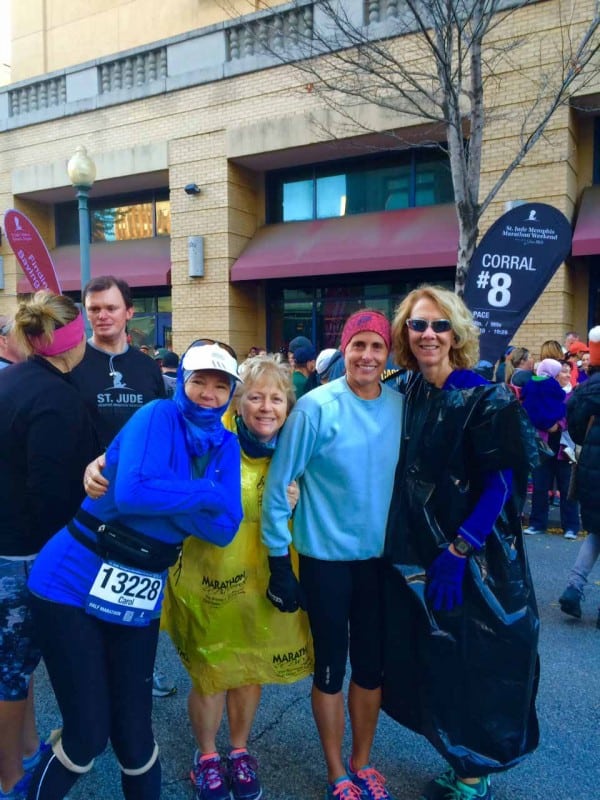
Jan squeezed in between two gal-pals before the start of the 2015 Memphis Marathon.
After her husband passed away from leukemia, running became a more spiritual relationship between the sport and to his memory.
“Racing became a way to connect to his memory, and I really enjoy it,” she said. “Running is a way now to enjoy time with friends.”
Jan says she enters five or six races a year, usually between June and December after her work with the race is over.
Jan’s first marathon was in 1989, the Lake City Marathon in Waukegan, Illinois, which doesn’t exist anymore.
“I ran 3:27,” she said. “It is still my PR. I ran my fastest time in my first marathon, which I think a lot of people do.”
Overall, Jan has run 30 to 40 half marathons, eight marathons, one 50k, and one eight-hour ultra. She has also run the Pikes Peak Ascent three times. Her marathons include Big Sur, Paris, New York City Marathon, and a favorite, Grandma’s Marathon in Minnesota.
Even with the end of her M&B career, Jan remains in the running circle. At the time of these interviews, Jan and Rich were attending the 11th annual Running USA Conference for race directors in Los Angeles.
She and Rich met with over 750 directors from all over the country, listening to as many seminars on the logistics of race directing as could be packed into the hours before the attendees were able to get out and watch the Olympic Marathon Trials.
As co-race director with Dave Hill of the Napa Valley Marathon in California, Rich says the job is an accumulation of positive and negative issues.
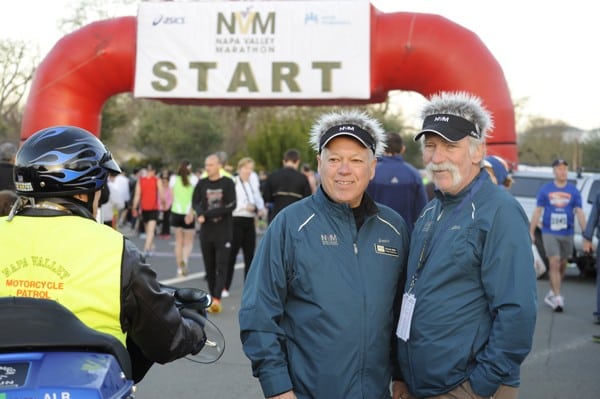
Co-directors, Dave Hill and Rich Benyo, at one of their Napa Valley Marathon races. The 2016 race was the 38th year.
“Race directing continues to change year to year,” he said, adding he won’t bore the readers with the endless amount of paperwork and tasks. “Thirty years ago long-distance runners were pretty independent and self-sufficient. It’s a whole different world today.”
Now, and this is not across the board he confirms, runners are spoiled.
“Several years ago, and I am not making this up, we had four complaints because we started the race on time,” he said. “Fortunately, since our race is in the wine-famous Napa Valley, when we state that some runners are going to drive us to drink, we don’t have far to go.”
To combat the negative aspects he now sees in the running world, Rich tries to give back to the community by volunteering. As an example, he’s volunteered at the Red Star Ridge Western States aid station since 1991.
“Rhonda has worked as the medical captain for 10 of those many years,” he said. “It’s a great aid station to work at because it is at 16 miles, so we camp out there Friday night, get up really early, and by 10:00 a.m. we’re done and we can go into Foresthill to socialize with all of our ultra friends.”
Rich is one of those ultrarunners with an extensive resume not many can match.
While writing the running column in San Francisco, he heard about two Santa Rosa runners who became the fifth and sixth runners to compete the route from Badwater in Death Valley to the peak of Mount Whitney. He interviewed them, Mike Witwer and Tom Crawford, who become the two spark plugs for creating the Badwater race.
Over beers, Rich and Crawford talked about Badwater logistics, mentioning how it was impossible to drive back the 12 miles from the peak to the portal, so to run or walk that distance one is already making the return trip back.
“Why not keep going and do the out-and-back,” he said he told Crawford. Apparently he nodded his head in agreement. “’But nobody’s ever done it; in fact, nobody’s ever tried it. You’d die in the effort,’ Crawford said.”
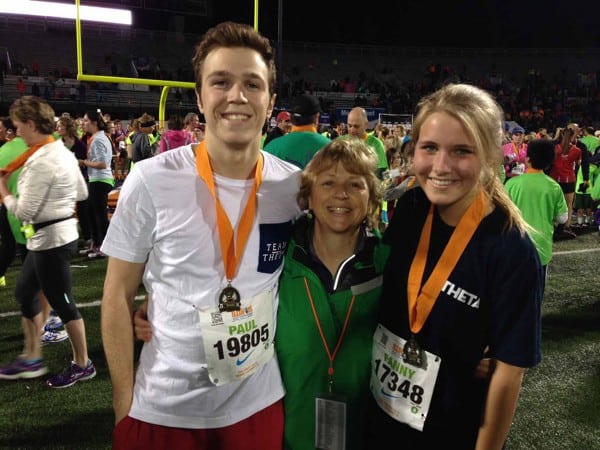
Jan with her son, Paul, and his friend, Fanny, after the 2015 5k which is part of the Christie Clinic race weekend.
With another beer in hand, Rich replied, “But that’s the beauty of it.”
Crawford agreed and said if Rich will try it, then he would try it with him.
The next day, after the beer-induced talk wore off, Crawford called Rich asking if the two really did make a pact to be the first two idiots to try to the out-and-back?
“Yes, we did,” Rich confirmed.
The two completed the adventure in 1989, and Rich returned to the valley two more times in 1991 and 1992, but it was on the third try that changed his running career forever.
“There was really ungodly weather,” he said. “It got up to 128 degrees [Fahrenheit] in the shade, although there is no shade, and I really broke myself down and opened myself to a viral infection in my heart.”
It took several years to figure out that the infection was more serious than it seemed to be, and years of pharmaceutical medications have transformed his running ever since.
His Badwater adventure with Crawford inducted the both of them into the Badwater Hall of Fame in 2004. He was then honored into the Running USA Hall of Champions in 2005 for his work with the Napa Valley Marathon and founding M&B.
Jan and Rich will always be remembered for their work with M&B, and they will continue to remember their time.
When the team announced the decision to end the magazine, the loyal readers were bereft, Jan said.
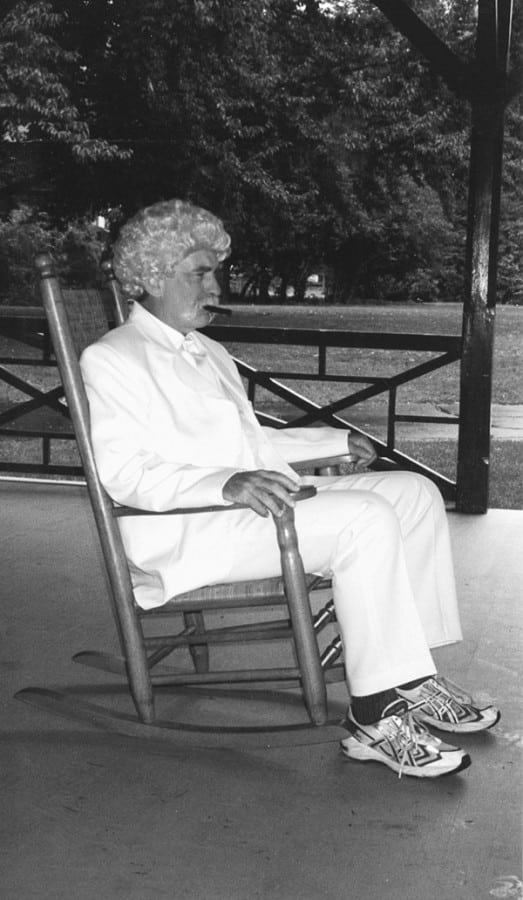
Rich impersonating Mark Twain during the 2006 Hartford Marathon. While sitting on the porch of Mark Twain’s house, Rich said he was asked if he was trying to look like Colonel Sanders.
Jan spent two to three hours a day consoling readers on the phone when they first announced, and still listens to saddened customers, now three months later. Rich said there is a stack of emails as thick as a book printed out in the office from readers wishing the two well.
The magazine was always different than other sports-related publications. They never had the huge band of followers, but printed each issue for a group of truly loyal readers.
“The magazine was always meant to mirror the demographics of the marathoning and ultra crowd, the highly educated who gather a lot of knowledge from reading, have long-term goals, a long attention span, and more,” Rich said.
The magazine was long-form writing: stuff that you wouldn’t find in other magazines because it was way too long, too in-depth, too “completely complete” as Bob Anderson, founder of Runner’s World used to call it, said Rich.
According to Rich though, the decline of readership and eventual cause of the end of the magazine was the end of the runners’ attention spans and disinterest in the history of running.
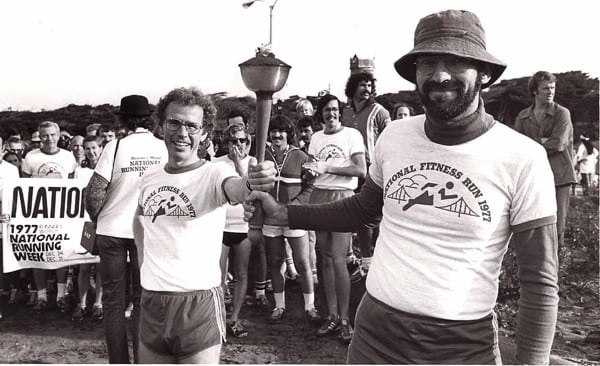
Joe Henderson symbolically handing the Runner’s World Torch as he took over the editor position. They both served the magazine for 7.5 years.
Circulation was dropping and not making enough revenue to keep it going, Jan said. The decision was thought about and decided in the late summer of 2015, and the two announced to the public that it was time to close the magazine’s covers for good.
“When we announced the decision, we sold thousands of back issues,” Jan said. “We have readers who really, really like the magazine, there just aren’t enough of them.”
Rich said he will never forget opening the never-ending manuscripts submitted and never knowing what he would find. He will miss working with the wonderful writers and artists, and the vast array of eccentrics brought up in the world of running a running magazine.
“We’ll always have the greatest affection for those wonderful people who made it possible to keep the magazine going for 19 years,” he said. “We love ‘em dearly.”

The final Marathon & Beyond cover.
